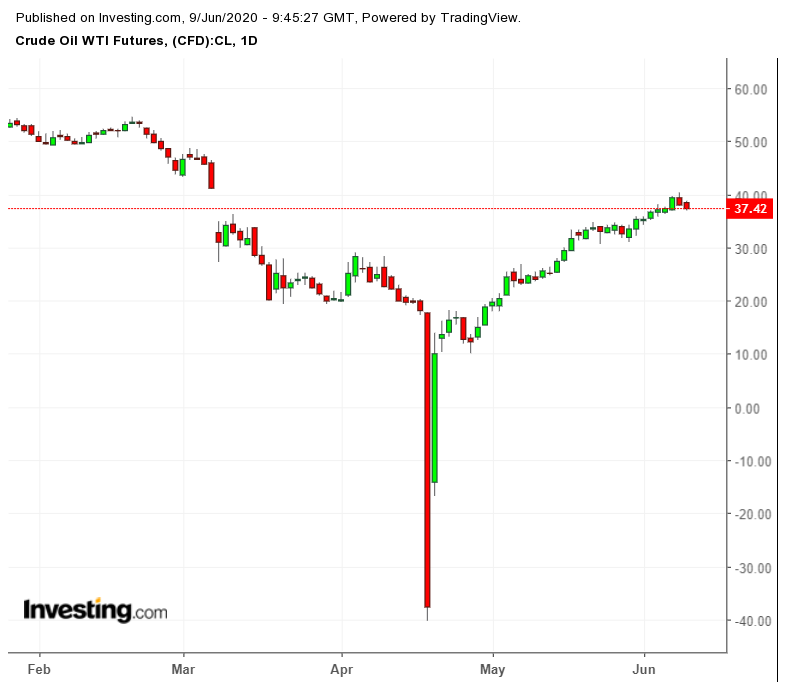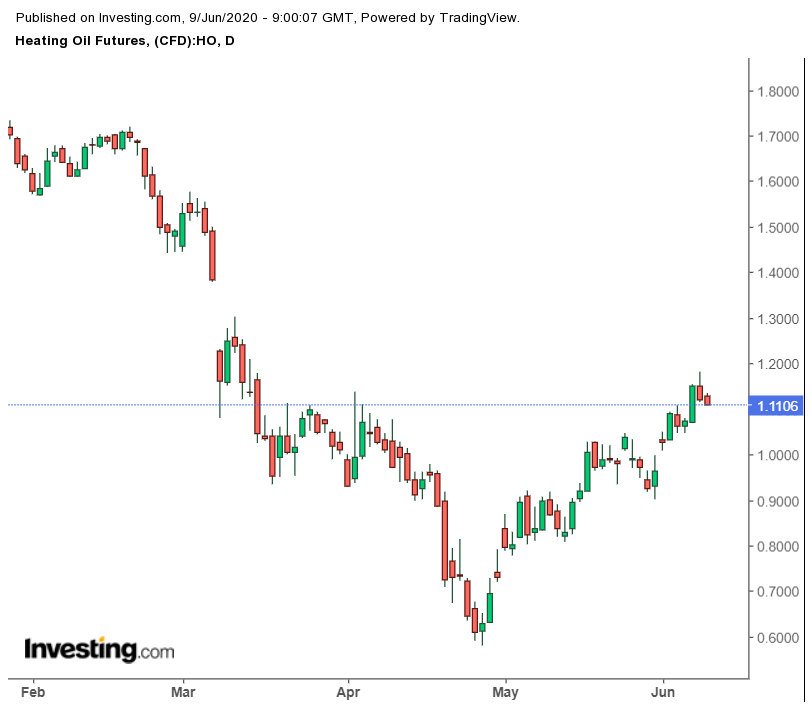
- All Instrument Types
- Indices
- Equities
- ETFs
- Funds
- Commodities
- Currencies
- Crypto
- Bonds
- Certificates
Please try another search

Planes, Trains And Automobiles - Oil Rally Will Need Them All

The Saudi swagger is back in oil as its leaders move their pieces on the crude chessboard with more certainty these days, compared to two months back, when the coronavirus pandemic barely gave them any winning maneuver. From raising prices in a rebounding market, to admonishing fellow exporters who weren’t cutting enough output, Saudi Arabia is doing all it can now to drain the global glut of oil.
Yet, for all their intent, Riyadh and its state oil company, Saudi Aramco (SE:2222), will need to see sizable demand return to all components of the fuel market, if they wish to achieve and maintain a backwardation in crude futures prices—where a barrel for prompt delivery fetches more than oil to be shipped months later, thereby encouraging anyone storing oil to sell it instead. All components of the fuel market means fuel for planes and diesel for trains and trucks as well, not just gasoline for automobiles.
Major airlines in North Asia have eased flight restrictions, lending some support to jet fuel refining margins and price differentials. They also offer a glimmer of hope to a sector ravaged by the grounding of planes and staff lay-offs by the thousands due to a near-zero rate of leisure travel at the height of the COVID-19 pandemic.
But, partly offsetting that trend, are European and U.S. refiners, making as little jet fuel as possible because aviation activity in those parts of the world is even worse than in Asia.
As a rule of thumb, these refiners use the "3-2-1 crack spread"—where for every three barrels of crude they process, two are made into gasoline and one into distillates, which can ultimately be jet fuel, diesel and marine bunker fuels. Demand for gasoline is fledgling, but in the case of jet fuel, it’s almost nada, because aviation activity remains far below pre-pandemic levels.
Diesel Demand Woefully Short Compared To Stockpiles
With more people in developed economies expected to drive to work than commute by bus, or train, to avoid infection when businesses reopen from shutdowns, refiners in the northern hemisphere are turning out more gasoline in anticipation of all that demand. But due to the 3:2:1 crack rule, they also need to boost their overall run rates. So, refineries are producing more diesel instead from the middle of the barrel, rather than jet fuel. That’s unfortunately landing more diesel on the market than there’s demand for.
"Diesel is the barometer of economic activity...demand is on the floor,” said Bob McNally at Washington-based consultancy Rapidan.
“Until you see diesel inventories decline, there's going to be a question mark over demand recovery,” said the author of “Crude Volatility: The History and the Future of Boom-Bust Oil Prices”, who has a combined experience of three decades as energy consultant, senior White House policy official and hedge fund strategist.
Alan Gelder, vice president for refining, chemicals and oil markets at consulting firm Wood Mackenzie Ltd, shares McNally’s view, telling Bloomberg in a report that “the world’s awash with diesel.”
“There’s just loads of it everywhere."
Their comments are underscored by the startling 51-million-barrel build in U.S. distillate stockpiles reported by the Energy Information Administration over the past nine weeks to the highest in 10 years. When the virus first broke out in the United States, e-commerce and deliveries ramped up, putting trucks on overtime runs. Surprisingly, the trend lasted for just about three weeks, despite the three-month long lockdown.
It could take a while to get all those distillates in storage, most of which is presumably diesel, moving back on to the market. In New York City, the epicenter of the U.S. COVID-19 outbreak, up to 400,000 people were estimated to have returned to work in its five boroughs on Monday, as the city reopened in stages from a 100-day shutdown. But some U.S. cities still have restrictions on activity. And while tens of thousands of people across the country have taken to the streets over the past two weeks to protest against police brutality and racial discrimination, many are still cautious about resuming life as they once knew it, meaning little commute or travel that would help diesel demand.
Even in Europe, where there are more diesel-powered cars than in the U.S., there is less demand than before the pandemic, due to reduced movement of freight and vehicles and machinery used in construction and agriculture.
Jet Fuel In Even Worse Predicament
Away from diesel, jet fuel is in a messy world of its own.
New York-based consultancy Energy Intelligence noted that when jet-kerosene prices crashed below their hedged prices, many airlines incurred substantial mark-to-market losses, forcing them to pay the hedged amount rather than the cheaper market price.
Airlines usually seek protection against a potential fuel price increase, typically using one-way hedges to purchase forward contracts that ensure them a lower price if the market rises substantially.
Some airlines, like Norwegian Air Shuttle (OL:NWC), have hedged only 25% of their 2020 fuel requirements, but others, like Ryanair (LON:RYA) and International Airlines Group (LON:ICAG), which owns British Airways and Iberia, have hedged up to 90% of their consumption.
In January, German carrier Lufthansa (DE:LHAG) said that a drop in crude prices to $45 per barrel would result in $800 million in hedging losses for the year, while Ryanair in April warned of a “record ineffectiveness” on its fuel hedges.
“Some have paid to exit their hedges,” Energy Intelligence said, noting that Australia’s Qantas Airways (ASX:QAN), which had hedged 100% of its fuel needs for 2020, announced on May 5 that it had closed out its over-hedged position through to September.
Other airlines are in an even worse predicament. Air France KLM (PA:AIRF) is still facing a hedging loss of nearly $1 billion, while EasyJet (LON:EZJ) has reportedly hedged at prices close to $90/bbl, against the prevailing $39 barrel now.
In the United States, Goldman Sachs estimates that jet fuel producers have 66% of their 2020 production hedged, up from 48% before the slump, and the highest level in at least five years.
Things are a little brighter on the Asian side of the industry.
Singapore Airlines (OTC:SINGY), Hong Kong’s Cathay Pacific Airways (HK:0293) and Cathay Dragon and all of South Korea’s carriers have announced more destinations, greater flight frequency, or both, in the coming weeks and months. Japan's ANA Holdings (T:9202) have also said they will start new weekly cargo flights.
"I think the jet fuel market is pretty supported now, with airline demand slowly coming back, but this does not mean that the aviation sector is out of the woods yet," a Singapore-based refining source told Platts, the energy news service of S&P Global.
"There is still a fear of flying and contracting the virus....We will have to wait and see what happens."
But U.S. carriers that incurred steep hedging losses now face a conundrum, Energy Intelligence noted:
“If they hedge, they may incur further losses by forfeiting future price gains if prices rise, while failing to hedge exposes them to the risk of even bigger losses if prices crash again.”
Related Articles

I recognize that there is a good case for gold at a time when the price level is rising steadily and there are upside risks to inflation and downside risks to the dollar. Let me...

Upon analysis of the wobbly moves since Tuesday, when the natural gas futures tested the two-year high at $4.55, Thursday might be a cozy one, as the inventory announcements after...

Energy prices remain under pressure amid demand concerns, while copper prices get a boost from tariff uncertainty Energy- Brent Breaks Below $70/bbl Sentiment remains negative in...
Are you sure you want to block %USER_NAME%?
By doing so, you and %USER_NAME% will not be able to see any of each other's Investing.com's posts.
%USER_NAME% was successfully added to your Block List
Since you’ve just unblocked this person, you must wait 48 hours before renewing the block.
I feel that this comment is:
Thank You!
Your report has been sent to our moderators for review







Add a Comment
We encourage you to use comments to engage with users, share your perspective and ask questions of authors and each other. However, in order to maintain the high level of discourse we’ve all come to value and expect, please keep the following criteria in mind:
Perpetrators of spam or abuse will be deleted from the site and prohibited from future registration at Investing.com’s discretion.